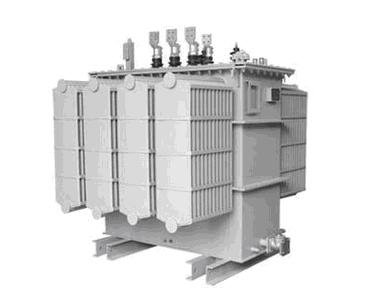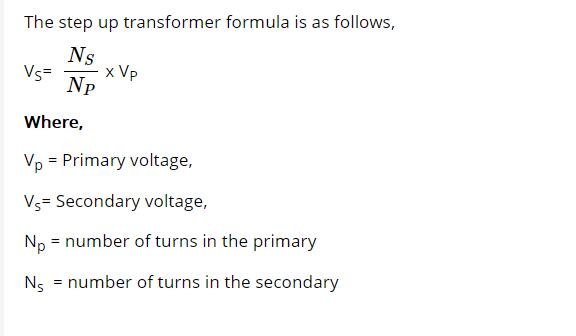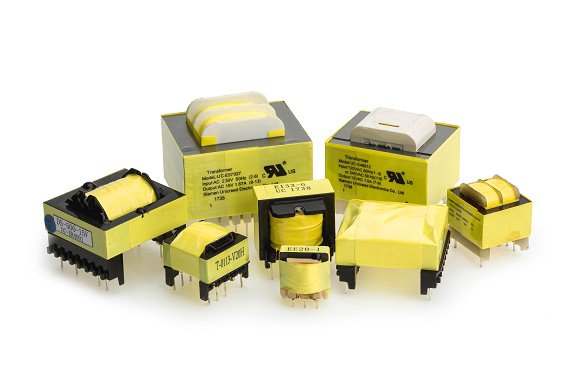The basic principles of step-up transformer and step-down transformer are the same.The main difference between a step-up transformer and a step-down transformer is their performance during their operation. The step-up transformer is designed to increase the output value, while the step-down transformer is designed to decrease it. Here, we discuss the differences between step-up transformers and step-down transformers, including definition, voltage,windings, conductor sizes, magnetic fields, and applications.
Step up transformer definition as follow:
A step-up transformer is a transformer used to change a low-voltage alternating current into a higher voltage alternating current with the same frequency, which is secondary current is higher than the primary voltage. In other words, there are more secondary winding than primary winding. For example, if you want to use a 220V device in some place with 110V electricity, you need a step-up transformer.

Step down transformer definition:
With a step down transformer, high voltage power from the power grid is reduced to low voltage for various electrical equipment to meet their needs. The step down transformer is a transformer that reduces the output voltage and converts the higher voltage at the input into a lower output voltage. In other words, it can convert a low current high voltage to a high-current low voltage, which is the purpose of a step down transformer.
10 Key differences between step-up transformers and step-down transformers in below table:
Comparison Chart
| Comparison Basis | Step Up Transformer | Step Down Transformer | |
| 1 | Definition | Step-up transformer increase the output voltage | Step-down transformer reduces the output voltage |
| 2 | Input voltage | The input voltage is low, but the output voltage is high | The input voltage is high, but the output voltage is low |
| 3 | Output Voltage | The output voltage of the Step-up transformer is more than that of the source voltage | The output voltage of the Step-down transformer is less than that of the source voltage |
| 4 | Secondary & Primary Winding | Low winding of the transformer is the primary, and High winding is secondary | High winding of the transformer is the primary and Low winding is secondary |
| 5 | Winding Turns | The number of turns in the primary winding is less than the secondary winding | High voltage winding is the primary winding |
| 6 | Current | Current is low on the secondary winding | Current is high on the secondary winding |
| 7 | Rating of output voltage | 11000 volts or more volts | 110v,24v, 20v,10v and so on |
| 8 | Magnetic Field | The magnetic and current fields are less developed in secondary windings than in primary windings | On secondary ends, voltage is low and magnetic field is high |
| 9 | Dimension of the conductor | Primary winding is made up of thick insulated copper wire | Secondary winding is made up of thick insulated copper wire |
| 10 | Application | Power plant,X-rays machine,microwaves and so on | Home Appliances, Inverters,Medical Equipment,Musical/Entertainment,PCB circuit modules,Electrical ,Radios, TV, VCR, CD Players, Shaver, Dish Antenna receivers, Laptop chargers, Printers, Stabilizers and electronic equipment and so on |
Step-up and Step-down Transformers formula
The step up transformer formula is as below:

The Step Down Transformer Formula is as Follows:

How to distinguish whether a transformer is a step-up transformer or a step-down transformer?
The transformer has two sets of coil turns N1 and N2, N1 is the primary and N2 is the secondary. An alternating voltage is applied to the primary coil, and an induced electromotive force will be generated at both ends of the secondary coil. When N2>N1, the induced electromotive force is higher than the voltage applied by the primary. This kind of transformer is called a step-up transformer; When N2<N1, the induced electromotive force is lower than the voltage applied by the primary. This kind of transformer is called a step-down transformer.
n=N1/N2
In the formula, n is called the voltage ratio (turn ratio). When n>1, then N1>N2, U1>U2, the transformer is a step-down transformer. On the contrary, it is a step-up transformer.

Can We Use Step-Down Transformer and Step Up One Alternately?
It is feasible to operate both of these transformer types backward, using an AC source to power the secondary winding and connecting the primary winding to a load. So by performing the opposite function, a step-down can function as a step-up and visa-versa. One of the conventions employed in the electric power industry is the usage of “H” designations for the winding (with higher voltage like the primary winding in a step-down system and the secondary winding in a step-up one) and “X” designations for the winding with lower voltage.
Metal type is a critical consideration when it comes to improving transformer efficiency and reducing heat generation. Windings made of copper are significantly more efficient than those made of aluminum and other metals. Nevertheless, it is also more expensive. The cost of copper-winding transformers is higher in the beginning, but they reduce electricity costs in the long run.
Conclusion
Between a step-up transformer and a step-down transformer, the step-up transformer increases the voltage output, while the step-down transformer decreases the voltage output.


